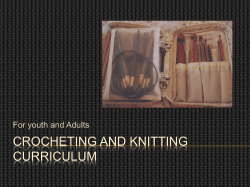
GLOSSARY OF TERMS FROM THE KNITWEAR AND HOSIERY INDUSTRY
Geoffrey Bowles and Siobhan Kirrane GLOSSARY OF TERMS FROM THE KNITWEAR AND HOSIERY INDUSTRY Knitting Together Memories of Leicestershire's Hosiery Industry Geoffrey Bowles Siobhan Kirrane HTTP://MYLEICESTERSHIRE.ORG.UK PATTERJ'IS OF WORK The factory workforce GLOSSARY OF TERMS FROM THE KNITWEAR AND HOSIERY INDUSTRY This glossary and all images are excerpts from the book Knitting Together: Memories of Leicestershire’s Hosiery Industry by Geoffrey Bowles and Siobhan Kirrane. The book was published in 1990 by the Leicestershire Museums, Arts, and Records Service, and is now available online at http://myleicestershire.org.uk. Right: Knitting on a fully fashioned stocking machine. Knitting on a fully fashioned stocking machine. 12 Glossary CIRCULAR MACHINE A knitting machine which makes a tube of fabric as opposed to a flat piece. First invented in 1806 and generally introduced from the 1860s. Now the most common form of industrial knitting machine. CONE The yarn as rewound in the factory, ready for the knitting machine. The conical shape helped the yarn to slip off without snagging. CUTTING Part of the making up process. Knitted fabric was cut with shears (scissors) by hand, or with a band knife or circular-bladed cutter. Both of these were in use by about 1912. 2 FASHIONING Shaping a flat fabric during knitting. This is done by varying the lengths of successive knitting courses. The product is known as 'fully fashioned.' GRISWOLD FINISHING HANDFRAME Operations performed on a knitted garment to make it ready for sale. The full list included scouring (washing), milling or fulling to improve the 'feel', bleaching and dyeing. Since the war, finishing operations have become much simpler. The first type of knitting machine, invented in 1589 by William Lee. It produced flat fabric, and was driven by the knitter's hands and feet. A small circular machine usually turned by hand and used to make socks. First patented in 1872 in America. HOSIERY FLATLOCKING A thoroughly confusing but essential term. Because the machine knitting industry began by making stocking or 'hose,' the term 'hosiery' became synonymous with the whole industry and is still used in this sense today. However, 'hosiery,' as applied to the industry's products refer only to stockings and tights (full hose and panty hose) and socks (three-quarter and half hose). A development of overlocking producing a flatter join, introduced in the 1920s. FULLY FASHIONED MACHINE A knitting machine which produces a flat fashioned fabric on a number of knitting sections turned by a single long shaft. First introduced by William Cotton of Loughborough in 1864. Used for high class work only, usually in fine gauges. 3 KNITTING MAKING UP Broadly, making an elastic fabric by looping one or more continuous yarns. Embraces both weft knitting, in which the courses go across the fabric - as in hand knitting - and warp knitting, where the courses go down the length of the fabric. Since the war, warp knitting has grown to become an industry in its own right. Joining knitted fabric pieces together to form a garment, and attaching fastenings, and so on, to it. Embraces seaming joining selvedges), cutting and sewing. OVERLOCKING Sewing cut edges of knitted fabric with a double chain stitch which covers the join to prevent fraying. Overlocking machines were first introduced in the 1880s. LlNKING Joining up the selvedges of a piece of knitted fabric loop for loop. The first linking machine was invented in 1858. Linking was a slow process whether done by hand or machine, suitable for high class work only. SEAMING See making up SEWING LOCKSTITCHING See making up Sewing with the basic domestic machine stitch. Used for attaching ornamentation to a knitted garment. SHEARS See cutting out LOOM Old term for warp knitting machines. Generally the only thing worse than calling a knitting yarn 'thread' is to call a knitting machine a 'loom.' THREAD Used for sewing or seaming knitted fabric pieces together for making garments. Not used for knitting - see yarn. 4 TRIMMING YARN PREPARATION Refers to the 'dry' finishing operations, particularly pressing. This was the counterpart to hand ironing, and was done in a steam press. A continuous process known as calendering could be used for some yarns. Before knitting some yarns needed lubrication with soap, oil or wax. Some knitting factories prepared their own yarn in this way. WELTING Knitted fabric unravels at top and bottom unless the first few courses (the 'welt') are turned in. Turning the welt was normally part of knitting, but sometimes the welt had to be formed afterwards on a sewing machine. This was known as welting. WINDING Before the war, spinners supplied yarn either in hanks or on cops, spools or cones, and it usually needed rewinding at the knitting factory. It was normally done on large multi-spindle machines, though hand winding also persisted. YARN The knitting industry's main raw material. Knitting yarn is softer and more pliable than thread. Before the war the yarns used were wool, worsted, cotton and silk, together with rayon or 'artificial silk,' which was introduced in 1906 and used for underwear and stockings. 5
© Copyright 2025

















